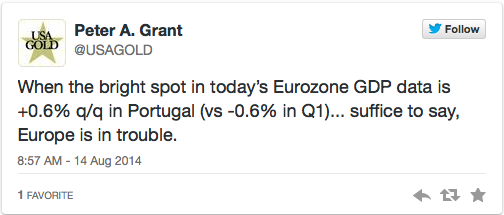Gold firmed to retest last week’s high at 1322.69 before settling back into the recent range. The yellow metal got a boost from the unexpected 21k surge in last week’s initial jobless claims. Geopolitical tensions and mounting growth risks in Europe are also seen as supportive.
Initial jobless claims for the week ended August 9 surged 21k to 311k, above expectations of 298k. This dilutes optimism on the labor front that emerged after the recent string of sub-300k claims prints, and nudges Fed tightening expectations back a bit.
More weak GDP numbers out of Europe are also escalating pressure on the ECB to ease further. German Q2 GDP contracted 0.2% q/q, France was flat. You may recall that Italy reported -0.2% Q2 GDP last week, putting that country in recession for the third time since 2008.
The eurozone as a whole was also flat in Q2. The annual pace of growth slowed further from +0.9% in Q1 to +0.7% in Q2. On top of that eurozone CPI was -0.7% in July, below expectations of -0.6%, versus +0.1% in June.

Of the three largest economies on the Continent, two contracted in Q2 and the best of them was flat. As I quipped via Twitter:

The euro remains defensive, near nine-month lows, amid mounting expectations that the ECB will be forced to act. This is helping to keep the dollar elevated, near eleven-month highs, against a basket of currencies. The relative strength of the greenback and buoyant U.S. stocks may be limiting gold’s upside for the time being.
WGC data show that physical gold demand was off 16% in Q2, versus the same period last year. This should come as no surprise to anyone as they are measuring against Q2-13, which saw just massive demand. I would suggest that 964 tonnes of demand is still a pretty robust number.
Despite some modest price volatility in Q2, gold ended that quarter +3.3% q/q and was up 10% since the first of the year. Not generally what one would expect of prices with such a drop in demand. Clearly it’s a little bit more complicated than the demand picture alone, havng just as much to do with supply.
The buoyancy of prices is indeed likely attributable to a tighter supply picture. After all, with prices dropping in 2013, the Chinese in particular were snapping up physical gold with abandon. Where did that supply come from? From the ETF vaults of course; as investors were repeatedly told there was no need for a haven and they had to be in stocks.
That meme was furthered by constant negative forecasts for the yellow metal. Everyone recalls Goldman Sachs Group (NYSE:GS) famously saying that gold was a “slam-dunk” sell.
In a recent interview, Tangent Capital’s Jim Rickards said the “big banks looted the GLD warehouse,” of 500 tonnes. “You can’t do that twice,” stated Rickards.
Rickards is spot on, as usual. ETF redemptions have slowed to a trickle and there have been recent adds to their holdings. The gold that came out of the ETF’s in 2013 is in Asia now, and it isn’t coming back. If investors take a renewed interest in gold for whatever reason — be it geopolitical, economic or some new financial crisis — they’ll have to pay a pretty penny to shake loose the necessary supply.
And jumping back to the demand side of the equation: Let us not overlook the fact that central bank demand for gold rose 28% in Q2, over the same period in 2013. It was the 14th consecutive quarter that central banks have accumulated more gold. Clearly the central banks see the value of having gold as a reserve. Don’t let ‘em talk you out of yours.
